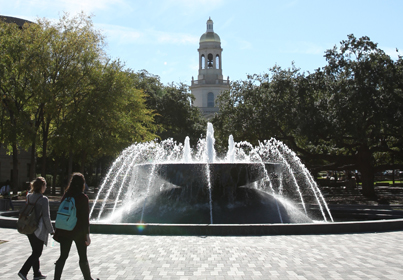Baylor receives third Sierra Club designation
Ongoing commitment to sustainability Again honored by the Sierra Club, which named Baylor to its 2016 "Cool Schools" list
Baylor is one of eight universities from Texas and one of three Big 12 Conference schools among the 201 four-year colleges and universities honored for their campus sustainability practices.
To determine the rankings, the Sierra Club collaborates with the Association for the Advancement of Sustainability in Higher Education (AASHE) to use raw data from AASHE’s STARS Reporting Tool, which gives colleges and universities a method for tracking and assessing their sustainability programs and scores the data across 64 questions. This year's scoring methodology was updated to reflect trends in campus sustainability, with emphasis on energy and transportation.
"What an honor it is to be named among the most environmentally friendly colleges and universities in the country," said Smith Getterman, assistant director of sustainability and special projects at Baylor. "This is the result of the hard work and dedication of our faculty, staff, students and even alumni. It's a testament to the fact that Baylor, as a Christian institution of higher education, takes our role very seriously as we work to be better stewards of our resources today and educate the leaders of tomorrow to do the same, wherever they go."
Getterman pointed out some specific successes last year, including 41,392 pounds of goods collected from students moving out of residence halls and apartments in May and donated to local nonprofits.
In addition, Campus Living & Learning recycled 368 mattresses from residence halls instead of sending them to landfills.
Sustainable 2020
Sustainable 2020, announced in April 2015, focuses on improving new levels of success in the stewardship of Baylor resources in the areas of dining, waste, energy and water by 2020. Below are updates as of 2015 on these five-year goals:
Dining
2020 Goal - 20 percent locally sourced food in residence hall cafeterias.
2015 Update: Locally sourced food in residence hall cafeterias increased to 11.9 percent.
Waste
2020 Goal - 30 percent diversion rate.
2015 Update: University diversion rate, which is the amount of waste kept from the landfill, increased to 21 percent, from a 2010 FY baseline.
Energy
2020 Goal - Reduce university greenhouse gas emissions 15 percent by 2020 from a 2010 FY baseline, including growth in university physical space and population.
2015 Update: Use of electric energy decreased by 9 percent, from a 2010 FY baseline.
Water
2020 Goal - Reduce university-wide water use 17 percent by 2020 from a 2010 FY baseline.
2015 Update: University-wide water use decreased by 20 percent overall, from a 2010 FY baseline.Note: 2016 updates will be released in the spring.
More information about the university’s sustainability efforts is available at baylor.edu/sustainability
